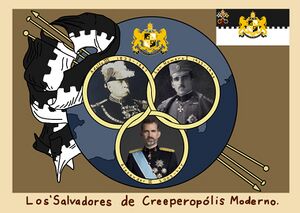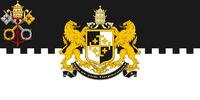Adolfo III of Creeperopolis
| Adolfo III | |
|---|---|
 | |
| Reign | June 14, 1833-December 1, 1887 |
| Coronation | September 15, 1833 |
| Predecessor | Manuel IV |
| Successor | Maximiliano II |
| Holy Protector of the State of the Church | |
| Reign | June 14, 1833-December 1, 1887 |
| Predecessor | Manuel IV |
| Successor | Maximiliano II |
| 1st Emperor of El Salvador | |
| Reign | July 10, 1858-December 1, 1887 |
| Successor | Maximiliano I |
| 23rd King of Senvar-Senvek | |
| Reign | March 5, 1839-December 1, 1887 |
| Predecessor | William III |
| Successor | Maximilian I |
| Born | April 3, 1803 |
| Died | December 1, 1887 (aged 83) |
| Spouse | Isabela Hernández Guerrero (m. 1822–1875) |
| Issue | |
| House | House of Martínez |
| Father | Salvador Martínez Ortega |
| Mother | Mary Schuessler González |
| Religion | Creeperian Catholicism |
Adolfo III of Creeperopolis (Full name: Adolfo III Alexander Martínez Schuessler; April 3, 1803-December 1, 1887) was the reigning Emperor of Creeperopolis and the Creeperans from 1833 to 1887. He rose to power in the Revolution of 1833 which deposed Emperor Manuel IV
He declared himself a new title in 1834, Emperor of Creeperopolis and the Creeperans, and ruled Creeperopolis as a theocratic institution with the Creeperian Catholic Church's laws of the faith as the laws of the Empire with the Ten Commandments as the highest laws. He expanded the relations between Creeperopolis and the Papal State.
He led and ordered the annexation of the Kingdom of Senvar-Senvek in 1839 and deposed King Wilhelm III which led to the First Senvarian Insurgency and, later, the Second Senvarian Insurgency.
He has posthumously been called Adolfo the Great, especially in the 21st century.
Early Life
Adolfo Alexander de Salvador Martínez González was born in the Salvador Imperial Palace in Salvador, Salvador, Creeperopolis. He was the second child of Grand Prince Salvador Martínez Ortega (1783-1829) and Grand Princess María Schuessler González (1783-1832). He had five siblings: Salvador (1801-1824), Carlos (1805-1854), María (1807-1889), Miguel (1810-1845) and Antonio (1815-1891). His paternal grandparents were claimants Emperor Salvador III and Empress María Ortega Hernández.
In his childhood, Adolfo lived within the Salvador Palace under the de facto house arrest of Manuel IV, his granduncle who defeated his grandfather during the War of the Creeperian Succession. He, along with the rest of his immediate family, was rarely allowed to leave. His grandmother, María, died under suspicious circumstances in 1806, and her funeral was held in Salvador. Adolfo attended the event, one of the few times he would leave the palace.
Military Life
From 1810-1822, Adolfo began to take an interest in the military history of Creeperopolis and had aspirations to become a military officer in the Imperial Army. He made a request to become an officer in the army, and after denying him three times prior, Manuel IV reluctantly allowed him to join the army.
Adolfo enrolled in the Imperial Army in 1822 and began as an Lieutenant, the lowest officer rank. Adolfo attended the Adolfosburg Military Academy where he was educated in military history, tactics, and skills to be promoted to Captain, which he was in 1826 after finishing his education. He was stationed in Helam, just south of San Salvador.
Adolfo married the daughter of the Emperor of Castilliano, Isabela Hernández Guerrero, on December 28, 1822, and they had their first child, Prince Maximiliano Adolfo Martínez Hernández, on June 18, 1824.
Adolfo was promoted to Major in 1829, but he wanted more. He was of royal descent, and he demanded that Manuel IV promote him to a higher rank. Manuel IV submitted and promoted Adolfo to Lieutenant-General in 1830, the fourth highest rank, after General, Field Marshal, and Chief Field Marshal.
As a Lieutenant-General, Adolfo gathered a following of soldiers who supported him, and many wished to establish him on the throne, as Manuel IV was growing old and was becoming an unpopular Emperor. Soldiers in the army began to only take orders from Adolfo by 1833. Manuel IV had enough of what he believed to be a mutiny against his orders, and stripped Adolfo of his rank and kicked him out of the Imperial Army on June 12, 1833.
Revolution
Upon hearing of the firing of Adolfo, many Generals and Field Marshals grew a bad taste for Manuel IV and defected to the cause of Adolfo. Adolfo had begun to rally up supporters in Helam and began marching his troops to San Salvador on June 13.
Manuel IV realized that the military is turning against him and orders for Adolfo's arrest, along with the arrest of any supporters. Manuel IV had Field Marshal Fidel Amaro Sánchez order the troops following Adolfo to arrest him, but the soldiers refused to listen. Amaro was then arrested by Adolfo's soldiers and executed via firing squad, marking the beginning of the Revolution of 1833.

Upon hearing the death of his most loyal Field Marshall, Manuel IV ordered the palace guards to arm themselves and defend the Imperial Palace of Creeperopolis to the death while he and his family hid within the palace preparing for the end, as the entire military has turned against him.
Adolfo recruited the help of Miguel Cabañeras Gutiérrez, a former Field Marshal who fought alongside Salvador III during the War of Succession, to depose Manuel IV from power. Adolfo promoted Miguel to Chief Field Marshal, signaling to the soldiers and officers that Adolfo is declaring himself as the true Emperor of Creeperopolis.
The soldiers arrived at the Imperial Palace at 12 noon and began to fire at the palace guards defending the palace. The well trained soldiers overwhelmed the outside defenders and infiltrated the palace. Cabañeras declared that no-quarter will be given to the palace guards, leading to very heavy guard fatalities.
The army had secured the palace by 3pm and had Manuel IV and his family captured and arrested.
At 3:30pm, Adolfo had Manuel IV and his heir, Grand Prince Manuel Martínez Figueroa, executed to prevent any claimant from Manuel IV's lineage arising to challenge his own power. The rest of his family was placed under house arrest and moved to the Salvador Imperial Palace, where Adolfo had been held prisoner throughout most of his childhood.
Adolfo declared himself Emperor of Creeperopolis and the Creeperans, Adolfo III, at 4pm, thus beginning his reign over Creeperopolis and establishing Salvador III's lineage on the Imperial throne of Creeperopolis.
Later that day, Adolfo III was given a letter from Pope Gregorio XVI himself congratulation him on his rise to power. He hopes that Adolfo III can revive and strengthen Creeperopolis's Creeperian Catholic heritage.
Reign
Adolfo III was officially coronated by Pope Gregorio XVI on September 15, 1833.
Adolfo III reversed many secularist policies imposed by Manuel IV during his reign, allowing the Creeperian Catholic Church to have enormous influence over the Empire. The Canon Catholic Law was imposed over the Empire as the highest law of the land in 1834 and the Ten Commandments were instituted as the highest of the highest laws. Creeperopolis was commonly labeled as a Theocracy because of these laws.
Economic Policy
On February 18, 1834, Adolfo III authored a manifesto called the Creeperian Investment into Natural Resources Gifted by God. His manifesto called for Creeperian workers to help the government mine gold, iron, and silver in the griund of the nation to help industrialize the nation. He claimed that God himself ordered him to write his manifesto and that God wanted all Creeperans to mine these minerals. The mainfesto gained popular support quickly, and on August 17, 1834, Adolfo III established the National Mining and Smelting Corporation, a massive conglomerate composed of subsidiaries which focus on mining and smelting iron, gold, and silver. Abbreviated as CORNAMIF, the corporation was given a monopoly on the Creeperian mining industry.
First Senvarian Insurgency
Adolfo III also vastly expanded the military power of Creeperopolis during his reign. On March 1, 1839, Adolfo III gave an ultimatum to the neighboring Kingdom of Senvar-Senvek to accept a peaceful annexation into Creeperopolis or face a devastating invasion. King Wilhelm III's military advisors begged him to refuse the ultimatum and go to war with Creeperopolis but he knew that his military was no match for Adolfo III's military might so he caved into the ultimatum.
Senvar-Senvek was absorbed into Creeperopolis on March 5, 1839 and Adolfo III was declared King Adolfo I of Senvar-Senvek. Wilhelm III was given compensation by free residence at the Palace of Port Senvek and Adolfo III promised that he and his family will be cared for. He gave Wilhelm III power over the administration of Port Senvek as a vassal to him.

Many Senvarians and Senvekians refused to accept Creeperian rule, however. Senvarian-Senvekian monarchists, loyalists, and nationalists, under the command of the King's brother, Frederick Schuessler I, fought the Creeperans refusing to accept annexation. The First Senvarian Insurgency, also called the First Senvar-Senvekian Insurgency, was Adolfo III's first true military conflict against a determined enemy.
The Creeperian Army's superior numbers, experience, and organization proved to be its greatest strength against the Senvarians' and Senvekians' lack of combat skill, smaller numbers, and lack of any sort of organization and unity. His troops' unity was exemplified during the Siege of Südhafen where his soldiers, despite outnumbered two to one, overpowered the Senvekians defending the city and its walls after four months of siege.
Adolfo III's army's greatest weakness was its lack of knowledge of the Senvarian and Senvekian landscape and terrain. The thick forests were perfect hideouts for insurgents to retreat to and rest only to prepare to attack the Creeperans over and over. The Senvarians and Senvekians mainly used guerrilla tactics which greatly reduced the efficiency of the Creeperian Army.
In the end however, the Creeperans triumphed when Frederick Schuessler I was killed in the Second Battle of Port Senvek in 1857. Over the course of the year, the Senvarians and Senvekians surrendered and accepted Creeperian rule. In return, Adolfo III agreed to enforce the Creeperian Constitution's granted autonomy the departments of Senvar and Senvek.
Inter-Insurgency Period
Following his military triumph over the Senvarians and Senvekians, Adolfo III looked to the northwest and set his sights on a conquest of the Salvadoran Kingdom.
The kingdom was surrounded on all sides by mountain ranges providing it protection from invasion. The kingdom itself lay in the Salvadoran Valley with its capital, Ciudad Los'Ángeles, lying on the Salvadoran River.
Adolfo III pressured the kingdom to submit to his rule after offering them vassal status instead of annexation in 1858 establishing the Principality of El Salvador. The Grand Prince of Creeperopolis was now considered the Grand Prince of El Salvador.
Second Senvarian Insurgency
In 1878, Adolfo III suspended autonomy for Senvar and Senvek and began treating the two departments just like any other Creeperian department. The decision was met by outrage from the Senvarians and Senvekians. Under Otto Schuessler I, the grandson of Frederick Schuessler I, the Senvarians and Senvekians rose up in a second guerrilla rebellion.
The insurgency was unpopular among the Creeperian populace and the people began protesting the war in 1881 demanding for it to end. Adolfo III ignored the people and continued the war.
The people began calls for the establishment of a second Parliament.
Death
Adolfo III died on December 1, 1887, from a stroke in the San Salvador Imperial Palace. He was succeeded by his son Maximiliano II. Maximiliano II accepted the peoples' cry and called for a cease fire to the war and arranged elections for a Second Parliament. The war would officially end on October 3, 1888, and Senvarian and Senvekian autonomy was restored.
Legacy

During the Second Parliamentary Era of Creeperopolis (1887-1933), Adolfo III was portrayed as a cruel tyrant and was viewed negatively by 60% of the Creeperian population, with only 35% viewing him favorably.
However, during the Creeperian Civil War, the Romerists portrayed Adolfo III in a positive light as an Emperor of the people and an Emperor of freedom and Catholicism.
After the 2003 Creeperian Coup D'état, the government of Alexander II, under orders of Augusto Cabañeras Gutiérrez, compared the coup of 2003 to the Revolution of 1833, a victory for Creeperopolis and a defeat for tyranny and oppression.
Adolfo III has been posthumously called "Adolfo the Great."
Issue
Adolfo III had eight children from his marriage to Empress Consort Isabela Hernández Guerrero.
Ancestry
| Ancestors of Adolfo III of Creeperopolis | ||||||||||||||||||||||||||||||||||||||||||||||||||||||||||||||||||||||||||||||||||||||||||||||||||||||||||||||||||||||||||||||||||||||||||||||||||||||||||||||||||||||||||||||||||||||||||||||||||||||||||||||||||||||||||||||||||||||
|---|---|---|---|---|---|---|---|---|---|---|---|---|---|---|---|---|---|---|---|---|---|---|---|---|---|---|---|---|---|---|---|---|---|---|---|---|---|---|---|---|---|---|---|---|---|---|---|---|---|---|---|---|---|---|---|---|---|---|---|---|---|---|---|---|---|---|---|---|---|---|---|---|---|---|---|---|---|---|---|---|---|---|---|---|---|---|---|---|---|---|---|---|---|---|---|---|---|---|---|---|---|---|---|---|---|---|---|---|---|---|---|---|---|---|---|---|---|---|---|---|---|---|---|---|---|---|---|---|---|---|---|---|---|---|---|---|---|---|---|---|---|---|---|---|---|---|---|---|---|---|---|---|---|---|---|---|---|---|---|---|---|---|---|---|---|---|---|---|---|---|---|---|---|---|---|---|---|---|---|---|---|---|---|---|---|---|---|---|---|---|---|---|---|---|---|---|---|---|---|---|---|---|---|---|---|---|---|---|---|---|---|---|---|---|---|---|---|---|---|---|---|---|---|---|---|---|---|---|---|---|
| ||||||||||||||||||||||||||||||||||||||||||||||||||||||||||||||||||||||||||||||||||||||||||||||||||||||||||||||||||||||||||||||||||||||||||||||||||||||||||||||||||||||||||||||||||||||||||||||||||||||||||||||||||||||||||||||||||||||
Titles, Styles, Honors, and Arms
Titles and Styles
| Royal styles of Emperor Adolfo III | |
|---|---|
 | |
| Reference style | His Imperial Majesty |
| Spoken style | Your Imperial Majesty |
| Alternative style | Sir |
Adolfo III's full title as Emperor was:
"By the Grace of the Lord, our God, Adolfo III, Emperor of Creeperopolis and the Creeperans, Imperial Commander-in-Chief of the Imperial Army of Creeperopolis, Imperial Commander-in-Chief of the Imperial Naval Forces of Creeperopolis, Holy Protector of the State of the Church, Emperor of El Salvador, King of Senvar-Senvek."
Honors
Domestic Decorations
| Country | Date | Decoration | Post-nominal letters |
|---|---|---|---|
| 1833 | Imperial Order of the Papal and Creeperian Cross | OI CPC | |
| Imperial Order of Miguel the Great | OI MIG | ||
| Imperial Cross of Alfonso the Great | OC ALG | ||
| Imperial Order of Manuel the Great | OI MAG | ||
| Order of the Crusaders’ Cross First Class | OCC PC | ||
| 1830 | Order of the Crusaders’ Cross Second Class | OCC SC | |
| 1833 | Order of the Star of the White Rose First Class | OERB PC | |
| 1829 | Order of the Star of the White Rose Second Class | OERB SC | |
| 1830 | Imperial Order of Valor and Bravery | OI VB | |
| 1833 | Imperial Order of the Cross of Carlos the Martyr | OI CCM | |
| 1831 | Order of the Golden Star’s Cross First Class | OCEO PC | |
| 1829 | Order of the Golden Star’s Cross Second Class | OCEO SC | |
| 1845 | Cross of Adolfo I First Class | CAD PC | |
| 1849 | Cross of Salvador III First Class | CSA PC | |
| 1826 1833 1839 1845 1857 1858 1878 1888 |
Star of the Imperial Army x8 (1888 posthumous) |
EEI |
Foreign Decorations
| Country | Date | Decoration | Post-nominal letters |
|---|---|---|---|
| 1833 | Supreme Order of Christ | OSC | |
| 1834 | Order of the Papal Star | OEP | |
| 1833 | Order of the Sacred Cross | OCS |





